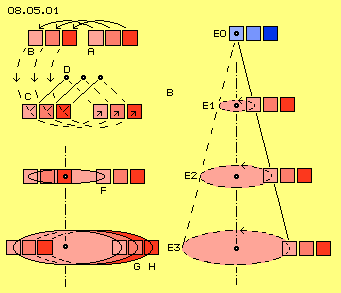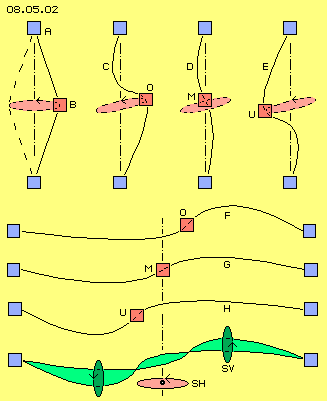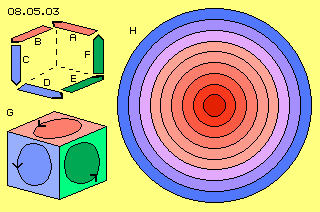Inevitable Movements
Locally limited units are potential vortices.
These necessities of aether movements now are visualized by some pictures and explained by following considerations.
Swinging
Difference between both shapes of motion can be shown by practical example: cutting-disk of a ´Flex´ (or mounted at drill) rotates around one axis, while grinding- or polishing-wheel of a ´Delta-Grind´ (or any other swing-grind-machine) is swinging. So here ´rotation´ is used in common sense as turning motion around only one axis, while term of ´swing resp. swinging´ exclusively is used for parallel motion around many fulcrums (for clear usage of terms, here ´swinging´ is not used for wave-movements).
Extension
Next to that aether can not exist wide movement. Short-radius swinging of resting aether can not transmit into long-radius swinging directly, but minimum swinging can change only gradually and smooth into swinging at longer radius. At distant levels E1, E2 and E3 thus aether well can swing at wider tracks, where here again all red marked aetherpoints keep their position relative to neighbours.
At micro- like macro-cosmos exist ´astronomic´ relations, e.g. nucleus of atom seems to be ten thousand times smaller than tracks of electrons running around. Relation between diameter of sun and sun-system as a whole is many times larger. So extension of swinging-radius will demand minimum relation of 1:10000. If radius of swinging at level E3 e.g. would be one millimetre, distance towards resting aether at level E0 must be assumed at least ten metres long. So here at these drawings, these relations are extremely overdrawn.
In order to point out that parallel swinging, left side at E2 the track-level of light-red aetherpoint F is marked as elliptic face. Below, at level E3 that face is correspondingly wider and there in addition are drawn overlaying track-planes G and H of both neighbouring aetherpoints.
So at one level, all neighbouring aetherpoints swing at parallel circle tracks. All neighbouring aetherpoints in vertical direction (see diagonal connecting line respective dotted line) are also swinging parallel, however top-down at each gradually wider circle track.
Double Cone
Swinging level can take gigantic scale, e.g. as core of Milky Way. Diameter of our galaxy has scale of 160000 light years. Milky Way however is only some 16000 light years ´thick´, distance between both ´poles´ resp. height of both ´swing-cones´ is rather short. A cone thus would be only 8000 light years long and thus diametre of central swinging could show maximum 0.8 light year.
Aether within that motion-system thus is swinging by 0.4 to and fro at equatorial plane. Connecting lines to resting aether left and right side are each 80000 long, respective alternating between 80000,4 and 79999,6 - what´s rather problematic within gapless, inelastic, incompressible aether.
Curved Connecting Lines
Aether is a ´fluidum´, however without particles. So comparison with water is not really true, as water exists by mutually shiftable particles. However, water is (nearby) as incompressible like aether. Water does not flow straight down mountains, but most smallest asymmetry results curved torrents up to mäander-shaped rivers. Just like this, at aether one my not assume and think by straight lines.
At this picture quite downside, all previous connecting lines are drawn together. Areas marked light-green show space for move of aetherpoints there. Starting point of considerations was swinging in horizontal level, here marked by horizontal ellipse SH. In reality, this plane will be some diagonal, like central light-green surface shows. These connecting curves won´t move straight up and down (because linear motions and standstill at death-points are not possible within continuously moving aether). So connecting lines will take their upside and downside positions by a vertical swinging movement (SV, marked dark green).
At this picture upside right are sketched longitudinal cross-sectional views through system axis. Central swinging-plane is marked by ellipse (light red), now here however at that diagonal arrangement. When red marked aetherpoint is positioned upside-right (at O), distance to upper pole is relative short, i.e. that upper connecting line C must be curved strong. At middle position (at M) connecting line D is curved some less. If aetherpoint did swing left-down (at U), connecting line E is rather stretched. Connecting line to bottom pole show analogue curvature.
Asymmetry
At previous picture for example, that vertical swinging (SV, marked dark green) is below equatorial level at the one side and upside of equator at the other side. Also vertical connecting lines show corresponding asymmetry and these lines thus won´t move perfectly parallel to central swinging.
When ever a curve is stronger bended, at ´inner and outer side´ different space exists. Exchange of these ´aether-volumes´ is only possible by overlaying swinging motions around that line. So inevitably these balancing motions won´t occur along straight line but around curved connecting lines. These curves are multiple bended into all directions, also stronger than really necessary - analogue to previous mäander-flow of water.
Stationary Wall respective rigid Sphere
At picture 08.05.03 schematic are sketched movements within that electron-room. Movement A is running from right to left side - and is running towards previous ´wall´. This motion can not go on into that direction, because theoretical all aether must be moving into that direction though total universe. This movement thus must swerve off, here e.g. towards B. Movement into old direction finally ends only when new direction shows exactly at right angles.
Winding Tracks
At this picture at G is visualized general statement: each motion within aether is swinging movement, which simultaneous occurs into all three dimensions of space. Realiter thus won´t exist swinging only at plane level and also not at pure circle tracks. All aether is swinging into all directions all times. It´s movement tracks are result of at least three overlaying circle tracks.
This is really hard to visualize and also to imagine, however schematic reduction at only two overlaying circle tracks or at only two dimensions can show essential facts quite well.
Right Angle Effect
That strong dependence of appearances and ´fields´ mutually arranged by right-angles are well known at electro-magnetism. These facts are well known, represented by formula exactly, used at techniques continuously, managed perfectly - only the real cause of that strange law is completely unknown. There is only one answer possible: that appearance occurs absolutely inevitable only if instead of abstract ´fields´ exist quite concrete movements of a real medium - and only if that aether is a gapless plasma.
An other important consequence results by that mutual dependency of movements: as soon as any motion is started at a location, motion can not stop but must go on and on. Motion processes of that spot practically is protected by previous ´wall or sphere´ of surrounding Free Aether. That´s e.g. reason why electrons are long-lived appearances. However this won´t mean, potentialvortexclouds are protected all times - also galaxies can crash.
Potential Vortices
Just this shape must show motion of local appearance of Bounded Aether, within wide space of all ambient Free Aether. At this picture, dark blue ring represents stationary aether. This is nearby resting resp. swinging at only minimum radius. Further inward (light blue rings) swinging motions become wider and just at centre (red areas) swinging movements occur at most wide tracks.
This is valid for ´twisting central axis´ from pole to pole. Smooth transition is relative easy, because previous ´cone´ of twisting connecting lines is simply enlarged from level to level. Some more difficult is transition from wide to narrow swinging in horizontal direction, because sideward shifting must be ´cushioned´. This is only achieved by curved connecting lines and as a result, equatorial plane becomes some diagonal arrangement.
That transition from outside towards inside is smooth (thus not by sharp steps like that simplified ring-model shows). That vortex-system thus well is locally concentrated, however has no sharp defined borders towards outside. That´s why I called that motion-pattern ´Potentialvortex - Cloud´. As it appears at most different scales, this pattern has general importance - it´s a must for local aether motions.
As mentioned before, nowhere within aether can exist any standstill. All must go on swinging, only length of radius of swinging is variable and also axis of swinging can ´twist´ within space. As a rule, many circle motions are overlaying, so uneven tracks and multiple ´motion-bundles´ result. Basic motion pattern of potentialvortexcloud is discussed once more at next chapter, however by some new aspects.
At particle-world nearby any motion is possible. Only within part-less aether-plasma, possibilities for motions are limited. Inevitable quite certain necessities for movements exist:
Each motion demands synchronous motion of neighbouring areas.
Motion can only occur in shape of swinging.
Each motion into a direction demands motion right angles to.
All motions all times occur into all three dimensions of space.
They show no fix outer border.
Starting from ´resting´ aether of environment
radius of swinging is gradually enlarged,
so motion-intensity is maximum at centre.
At picture 08.05.01 again these three neighbouring aetherpoints are drawn, each marked by different red colours. Aether at A moves at circle-section towards B and further on to C (and will go on moving at complete circled track). Aetherpoint marked light-red is located left side - and during total movement this aetherpoint will stay left side of his neighbours. This aetherpoint is turning around a fulcrum D (marked black). His right-hand neighbours are not turning around that point D but around their own fulcrums, each shifted correspondingly towards right. This motion is basic shape of movements within aether. That´s no rotation like at previous chapter, where an aetherpoint stays in front (in turning sense) of his neighbours, so all aetherpoints are turning at circle track, commonly around only one centre. Opposite, here all neighbours are turning around each own (neighbouring) centre. All aetherpoints all times stay at likely side of their neighbours. All neighbouring aetherpoints thus are swinging parallel at neighbouring circles.
This motion is basic shape of movements within aether. That´s no rotation like at previous chapter, where an aetherpoint stays in front (in turning sense) of his neighbours, so all aetherpoints are turning at circle track, commonly around only one centre. Opposite, here all neighbours are turning around each own (neighbouring) centre. All aetherpoints all times stay at likely side of their neighbours. All neighbouring aetherpoints thus are swinging parallel at neighbouring circles.
All aether is steady moving, however Free Aether is swinging by minimum radius. This aether thus is called (practically) ´resting´. Right side of that picture at E0 are marked three aetherpoints by different blue colours, representing resting aether.
At picture 08.05.02 at A, again are sketched resting aether (blue) and at B a level of most wide swinging (red). Connecting line between A and B marks vertical neighbouring aetherpoints. Based on swinging motion, that connecting line described surface of a cone. Further down, that extended swinging must also be reduced towards resting aether (at bottom, also marked blue), i.e. that ´swing-cone´ must be symmetric.
 At downside part of that picture, blue marked aetherpoints represent resting aether, left and right side of motion-system. Red marked aetherpoint is positioned right side (at O) of system axis, just at centre (at M) or at left side (at U), while swinging around system-axis. Connecting lines are drawn towards resting aether aside. Previous difference is only to handle, if these connecting lines are more (at F) or less (at H) curved, and only at central position are somehow symmetric (at G). That curve naturally again is extreme overdrawn, while real relation here would be about 1:200000 (so 1 mm at 200 m).
At downside part of that picture, blue marked aetherpoints represent resting aether, left and right side of motion-system. Red marked aetherpoint is positioned right side (at O) of system axis, just at centre (at M) or at left side (at U), while swinging around system-axis. Connecting lines are drawn towards resting aether aside. Previous difference is only to handle, if these connecting lines are more (at F) or less (at H) curved, and only at central position are somehow symmetric (at G). That curve naturally again is extreme overdrawn, while real relation here would be about 1:200000 (so 1 mm at 200 m).
Technologists at first think by straight lines and perfect circles. Previous example of water flows however shows, ´nature´ works much more flexible and movements rarely are bound to our geometric ideal ideas. Also Milky Way is no example of perfect discus but shows rather ´confused picture with imperfect spiral arms´. So one must not assume, motions within that vortex-system are totally symmetric.
By my conviction, such ´potentialvortexclouds´ are a widespread motion pattern within aether. Not only galaxies and sun-systems but e.g. also electrons exist by movements of that shape. Diameter of electrons is about 10^-16 m, so are ´half-pints´ within vacuum or surrounded nothing - by common understanding. In reality, around these ´particles´ is Free Aether, which is stationary and resting respective is swinging at only ´quant-small´ radius. That Free Aether thus builds a ´massif wall´ or ´solid hollow-sphere´ around that spot representing an electron - however this spot is much wider than commonly assumed.
 Motion B however hits onto aether already existing there, which same time must escape right angles in direction C. Analogue is valid for D and E. Finally movement F ´fills up´ space which movement A did leave - so ´cat catches its tail´. However, that closed loop can not be done by rotation, but only by overlaying swinging motions. Movements naturally won´t run linear and each cross by right angles, but movement continuously will run at curved tracks.
Motion B however hits onto aether already existing there, which same time must escape right angles in direction C. Analogue is valid for D and E. Finally movement F ´fills up´ space which movement A did leave - so ´cat catches its tail´. However, that closed loop can not be done by rotation, but only by overlaying swinging motions. Movements naturally won´t run linear and each cross by right angles, but movement continuously will run at curved tracks.
This principle is of general importance: motions can not run infinite long in a direction and only redirection by exact right angles can solve problem. As all swinging, no matter how complex, comes back to starting point, all movements are mutually conditional. Here e.g. motion A can not start by itself, but total circuit can come up only as a whole.
Previous picture right side at H visualizes an other basic principle of local aether movements. At our common particle-world we well know turning movements in shape of rotation, everywhere axis and wheels are rotating. These ´rigid vortices´ has characteristic of most fast motion at their circumference. Opposite motion principle are ´potential-vortices´ where most intensive motions exist at centre.
08.06. Real and seeming Motions
08. Something Moving